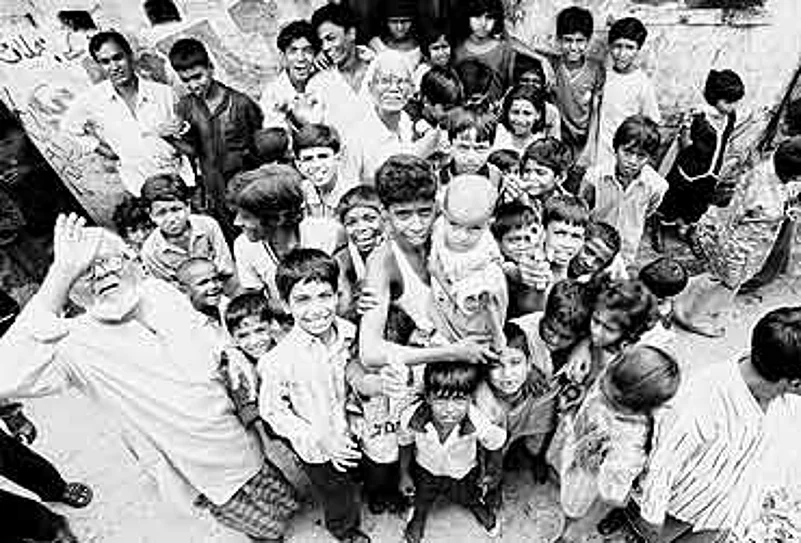Until recently, the lion’s share of the research on income and happiness focused on relatively rich individuals—the Birlas and Bill Gateses. Not much is known about the happiness of those living without access to air-conditioning, swimming pools and Harry Potter. I have spent my professional life attempting to fill this gap in scientific knowledge by researching on the "subjective well-being" of people who live a simple lifestyle. Some of these groups, such as Calcutta’s sex workers, are victims of circumstance, birth, or unfavourable economic trends. Other groups I have studied, such as the Amish, a Christian group in the US who reject the use of conveniences such as electricity and cars, choose their lifestyle. Others I have worked with, such as seal-hunters in the Arctic or tribal Kenyans, are forced to survive in their harsh environs.

My most fascinating findings are the largely counter-intuitive results from my work among the pavement-dwellers, slum-dwellers and sex workers of Calcutta. Take Kalpana, a woman I spoke to in Belgachia—a Muslim slum in north Calcutta—who endured the hardship of losing two children to malnutrition and the frustration of her husband’s unemployment. Like thousands of other pavement-dwellers in the city, she occupies a narrow patch of sidewalk with her family. They own clothes, blankets, a tarpaulin and cookware; and the two surviving children spend each day scouting a park for sticks and rubbish—anything that can fuel a cooking fire. Kalpana earns Rs 200 a week by cleaning the home of a man who manages a jute business. When I spoke with her, she complained about the possibility of being evicted from the sidewalk by the police and worried about the approaching monsoons. Yet, when I tallied up my measures of subjective well-being, I was found that Kalpana was not unhappy.
This was the trend I found across nearly 200 interviews with sex workers and pavement-dwellers in Calcutta. Although the people I spoke with were certainly not flourishing, they were also not faring as badly as I had thought, scoring around the neutral point of measures of happiness (see graph). When compared with the hundreds of homeless Americans I had interviewed, Calcutta’s destitute were quite happy. The American homeless—people who had relatively better access to food, shelter, and social and health services than their Indian counterparts—reported extremely low levels of happiness, similar to what we find in studies of prisoners and patients in mental hospitals.
One of the places I conducted my research in the US was in Fresno, California. At nearly one million people, Fresno is a largely working-class city, with a large Mexican population. One afternoon, I met a man named Mike, who slept in an abandoned car he found in the local warehouse district. A year before I met him, Mike had owned 12 jewellery stores. To keep up with the increasing work pressure, he took to drugs. Within months, he was embezzling from his own company to fund his addiction and cheating on his wife. Half a year later, Mike was divorced, hadn’t spoken with his kids, was bankrupt, and facing criminal charges related to his business. Mike was mugged twice and was afraid of the local gangs. Mike’s story turned out to be typical of the homeless people in the US; people whose stories often involved drugs, divorce, and violent street crime.
Not that alcoholism, drug abuse bullying and theft don’t occur in Indian cities—they do—but there are many aspects of Indian culture that serve to buffer the poor from the harmful effects of poverty. Fate, bad luck and macroeconomic factors beyond individual control are often used to explain the lot of the unfortunate in India. In the US, poverty is looked at as the result of a personal failure and poor coping means such as drug use. Another reason Kalpana and her ilk are faring better than homeless Americans like Mike is due to India’s strong social fabric. Whereas people living on America’s streets are often divorced and estranged from their families, there are tremendous pressures in Indian society for families to remain connected, even in hardship. Thus, when an Indian ends up living on the street, it is often with his family, and sharing a pavement with a community of other homeless people who can provide physical and emotional security.
This sense of community, a counterpoint to the mistrust and dysfunction of American street life, can be seen in the comments of a taxi driver from Bihar. When I met him, Krishna slept on the sidewalk, just off the busy commercial thoroughfare of Gariahat Junction, in Calcutta. "I had a room," he said. "But it was lonely, and I worried about thieves taking my things. Now, I live on the street with the other drivers." Indeed, in the evenings, one can see a line of Ambassador taxis parked beside groups of Oriyas and Biharis in undershirts playing cards, napping, and gossiping. Although there is some petty theft and low wages and long working hours result in hunger and health problems, the men are relatively happy. This fits well with the results of many studies that show having good social relations as being crucial to happiness.
Even the sex workers, who frequently have tales of bad childhoods and dismal working conditions, often find comfort in their children, their peers and, at times, their husbands. While the results of subjective well-being studies suggest that romantic notions of the "noble poor" are not entirely accurate, nor do they support the idea that money alone can buy happiness. Watching Indira hold her son on my seventh wedding anniversary, it was clear to me that happiness is much more than a financial bottomline, and that this emotional ledger is not best tallied in rupees or dollars, but in relationships.
(Robert Biswas-Diener is a psychologist at Portland State University.)
















